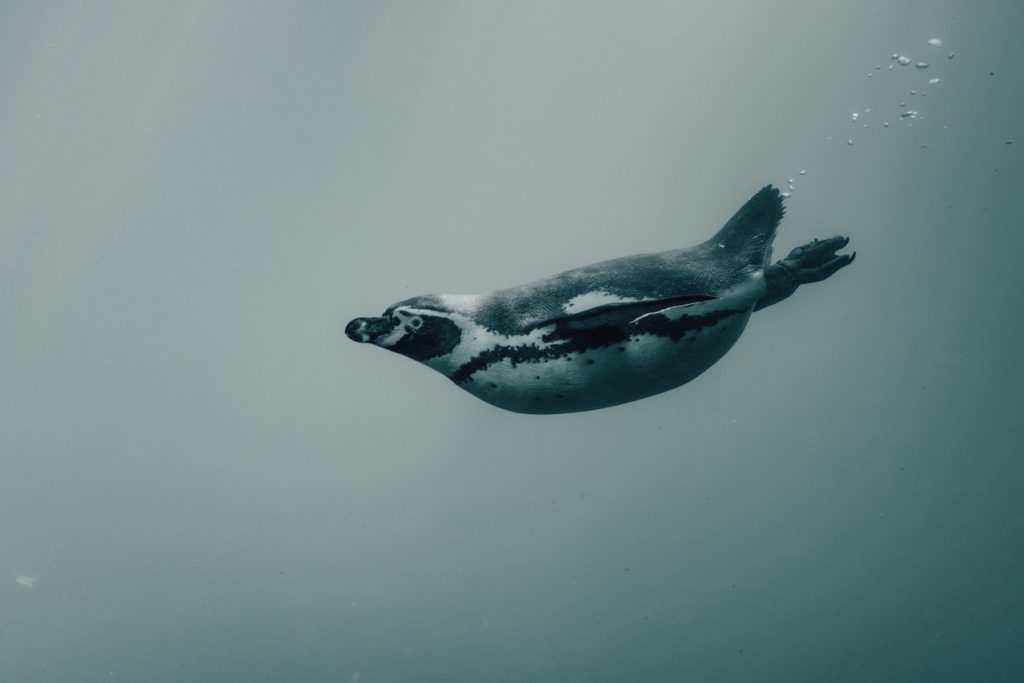
Could penguins fly in the past? Yes, they could, but millions of years ago.
There are many birds that could fly at some point but that have lost the ability. The Galapagos Cormorant is a good example. They are only found on two of the Galapagos islands. They are not originally from the island, so their ancestors must have flown there at some point, but since then they have lost the ability to fly. This is because there are no predators to escape from and there is an abundant source of food in the sea. For most birds, being able to fly provides an advantage, but for the Galapagos Cormorant, it doesn’t. Being able to swim provides them with more of an advantage.
And this is probably what happened to penguins. As recently as 55 million years ago, there were penguins that could fly. They wouldn’t have looked anything like the species of penguins that exist today and would probably have resembled some of the diving birds that exist now. There are no fossils of these birds, but scientists are sure that penguins were able to fly at some time because flightless birds don’t tend to survive mass extinction events and penguins have. Birds that cannot fly are unable to spread out and find new food sources.
So, why would penguins have lost the ability to fly? There are several reasons. Firstly, evolution tends to select for something that has more use. If birds are reliant on flying, then evolution selects for the birds that fly the best. If animals are reliant on swimming, then evolution selects for the animals in the species that swim the best. Evolution helps animals specialize in their area. Of course, there are birds that both fly and swim, but they don’t fly as well as other birds and they don’t swim as well as penguins. The common murre is a good example. They are probably as close to a flying penguin as you could get. They can fly, but they have the highest wing load of any bird, which means it is hard for them to take off and they are not very agile. They hunt for their food in the sea, and they can swim underwater for about 30 m, but they cannot hold their breath long enough, and they are not insulated enough to stay down longer. They use their webbed feet to swim, but their wings are no use in the water. It is probable that they will lose the ability to fly at some point in the future.
A second reason is the energy cost of flight. Animals and insects that fly have to use a lot of energy. It is not easy to flap their wings enough to stay airborne. Dragonflies, hummingbirds, and of course, larger birds, have to eat a large amount of food to be able to fly. Many birds spend the majority of their time sitting on trees and only fly when they have to. They fly because it is easier to catch their food and escape from predators that way, but they have to catch more food to be able to fly. Penguins swim and there is a far lower energy cost involved with swimming.
A third reason is that they can be heavier. Birds have hollow bones because they need to be light. The heavier a bird is, the more energy it would need to fly. Penguins don’t have hollow bones because they need to be able to dive in the water and hollow bones would make them too buoyant. Penguins also need to be insulated to survive in the cold sea. This requires some fat and a thick layer of different types of feathers. Feathers that can insulate an animal in the Antarctic Sea are not the same feathers that can help a bird fly.
Once penguins lost the ability to fly, they evolved some other adaptations as well. Their hemoglobin is able to hold far more oxygen than birds and they can survive a much higher lactic acid buildup. This allows them to dive deep into the sea, in the same way that whales do. Some emperor penguins have dived down to 500 m. They are also able to slow down their heart rate to five beats a minute.
Their color changed as well. Birds tend to spend a lot of time sitting around, so they are usually camouflaged to look like the thing they sit on. A lot of birds look like trees, or rocks. Penguins have evolved their dual-colored camouflage. They are white on the bottom because any predator looking up from deep in the sea will have trouble seeing them against the light reflecting off the surface of the sea. And they are black on the top because any predator looking down from the sky would have trouble seeing them against the darker color of the deep sea.
So, could penguins fly at some point? Yes, millions of years ago, but they have adapted to be much better swimmers.
Sources
https://en.wikipedia.org/wiki/Penguin
https://www.wonderopolis.org/wonder/why-cant-penguins-fly
https://www.abc.net.au/science/articles/2013/05/22/3764730.htm
https://en.wikipedia.org/wiki/Common_murre
https://sciencing.com/penguins-breathe-underwater-4566655.html
